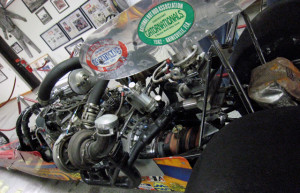 More can be better when it comes to forced induction. The Al Lidert Golden Gator rear-engine dragster ran with Chase Knight at the wheel, a supercharger on top of the intake manifold, and not one but two turbochargers feeding the 464 cubic-inch hemi engine underneath all the plumbing. Two turbos boosting a supercharger through a Hilborn mechanical fuel injection system at 60 pounds per square inch of boost huffed a lot of alcohol – and won a lot of races. Knight and Lidert ran the Golden Gator from 1971-1982, with the car hitting the performance mark in Pro Comp at the 1973 NHRA Gatornationals. The combination worked so well that the powers took notice.
More can be better when it comes to forced induction. The Al Lidert Golden Gator rear-engine dragster ran with Chase Knight at the wheel, a supercharger on top of the intake manifold, and not one but two turbochargers feeding the 464 cubic-inch hemi engine underneath all the plumbing. Two turbos boosting a supercharger through a Hilborn mechanical fuel injection system at 60 pounds per square inch of boost huffed a lot of alcohol – and won a lot of races. Knight and Lidert ran the Golden Gator from 1971-1982, with the car hitting the performance mark in Pro Comp at the 1973 NHRA Gatornationals. The combination worked so well that the powers took notice.
“The NHRA was very unhappy with us after the ’73 Gatornationals”, said Knight.
It all started with a letter. Al Lidert was in the business of metal stamping and precision spring manufacture when he sent an introductory letter to Chase Knight, who was at the time piloting a twin-engine gasoline dragster in Super Eliminator. Chase recalls opening the letter from Lidert, and seeing what looked like a carefully dismantled insect under a piece of scotch tape at the bottom of the page. After reading an introduction and Lidert’s plan for the Golden Gator, Chase got an explanation of the tape. Under the tape was 112 Lidert springs, each measuring mere thousandths of an inch! Chase accepted the driver spot, and strapped in ahead of the triple-boosted hemi for over 10 years.
The Golden Gator was first run on gasoline, which gave way to a more forgiving methanol alcohol. Gauges mounted at key points in the system allowed the team to keep track of fuel pressure and boost. According to Knight, the most difficult part of the game was keeping track of fuel curve with the entirely mechanical fuel injection system. Lidert at one point wired up a remote servo transmitter to the wastegate, so that he could monitor the boost pressure as the Golden Gator chomped down the track. Knight says 60 pounds of boost was the normal, with 70 pounds as a peak boost level. Mid six-second quarter miles at 200 plus miles per hour were the result.
Despite NHRA attempts to slow the Golden Gator down by throwing weight on the car, or banning it outright by claiming it was too fast for its class, the Golden Gator kept on going until being sold in 1983, and then auctioned into static service as restaurant attraction. The car was thankfully rescued after the restaurant in which it was on display went kaput. And while Al Lidert has moved onto the big drag strip, the Golden Gator lives on at the Big Daddy Don Garlits Museum of Drag Racing. Chase Knight? You can find him at work as Valve Train Product Manager at Crane Cams in Daytona Beach, Florida, USA.
Thanks to Chase Knight at Crane Cams for helping Clunkbucket sort out the legend of the Golden Gator, the Big Daddy Don Garlits Museum of Drag Racing for helping us find the Golden Gator in the first place, and Karen Kirwan for taking these pictures of the Golden Gator.










You know, I’ve got a good friend out east running an Eaton M92 supercharger *and* a Garrett GT35R turbocharger on his 2.4L Mitsubishi 4G63T. He makes something like 25psi from 2000rpm to redline and daily drives it.
I had a chance to drive the twincharged Talon a couple times and it’s amazing how smooth and linear the power comes online. Turbo lag is only an entry in the dictionary in cars like these. I can only imagine how turbos of that size forcing such a high volume of charge to over 60psi would feel. Probably like being rear-ended by a semi doing a buck twenty.
Glad to hear this piece of history is somewhere it will be respected now.
I love the quick disconnect on the pressure side of the turbos.
In my line of work we routinely specify two-stage refrigeration compressor systems. Primary compressors take some of the load and then booster compressors kick on as needed to increase the heat removal. This is essentially the same thing, I suppose. It would run 100% all the time, though.